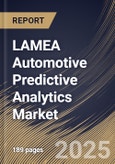The Brazil market dominated the LAMEA Automotive Predictive Analytics Market by country in 2024, and is expected to continue to be a dominant market till 2032; thereby, achieving a market value of $341.7 million by 2032. The Argentina market is showcasing a CAGR of 31.7% during 2025-2032. Additionally, the UAE market would register a CAGR of 28.9% during 2025-2032. The Brazil and UAE led the LAMEA Automotive Predictive Analytics Market by Country with a market share of 34.2% and 13.9% in 2024. The South Africa market is expected to witness a CAGR of 31.2% during throughout the forecast period.
Over the past ten years, the LAMEA region has moved from reactive and diagnostic automotive analytics to advanced predictive systems. This change has been driven by the growing use of telematics, the modernization of fleets, and government-backed smart infrastructure projects. Early deployments in Latin America, the Middle East, and Africa were limited to specific areas like engine diagnostics, battery health, and monitoring of critical components. This made it possible to test the predictive value of these systems in lowering unplanned downtime and operating costs. More powerful telematics, cloud-edge computing architectures, scalable data pipelines, and the rise of electric vehicles have all contributed to the rapid growth of predictive analytics in the 2020s. This has led to new uses for battery degradation forecasting, route optimization, and energy efficiency. Edge-cloud hybrid frameworks, contextual calibration for local environmental conditions, and platform integration have become key enablers, ensuring resilience, predictive accuracy, and systemic applicability across diverse geographies.
The top companies in LAMEA use a mix of local partnerships, modular platform architectures, and iterative learning to provide predictive insights as service-based offerings. Strategic partnerships with regional operators and local calibration centers improve contextual accuracy, compliance with regulations, and respect for data sovereignty. Modular and reusable platform parts speed up deployment while still allowing for customization for specific fleets or regions. Service-oriented monetization, such as predictive maintenance contracts and operational dashboards, aligns the interests of providers with those of clients, which leads to ongoing improvement. The competition is shaped by the tension between global expertise and local adaptation, full-stack versus niche solutions, data access, regulatory compliance, and co-opetition. Companies that can successfully combine advanced analytics with deep regional insights will have a clear advantage in LAMEA's changing automotive predictive analytics market.
Component Outlook
Based on Component, the market is segmented into Software, Services, and Hardware. Among various UAE Automotive Predictive Analytics Market by Component; The Software market achieved a market size of USD $9.4 Million in 2024 and is expected to grow at a CAGR of 28.2 % during the forecast period. The Hardware market is predicted to experience a CAGR of 29.9% throughout the forecast period from (2025 - 2032).Vehicle Type Outlook
Based on Vehicle Type, the market is segmented into Passenger Cars, Commercial Vehicles, and Electric Vehicles (EVs). The Passenger Cars market segment dominated the Brazil Automotive Predictive Analytics Market by Vehicle Type is expected to grow at a CAGR of 28.3 % during the forecast period thereby continuing its dominance until 2032. Also, The Electric Vehicles (EVs) market is anticipated to grow as a CAGR of 29.9 % during the forecast period during 2025-2032.Country Outlook
Brazil is the biggest car market in Latin America and a leader in the use of predictive analytics in the region. This is because of a strong network of OEMs, suppliers, and aftermarket networks. Predictive solutions cover a wide range of areas, such as predicting when a vehicle will break down, scheduling maintenance, managing warranty and recall risks, optimizing fleets, and monitoring the health of new electric vehicle batteries. These solutions work in a variety of conditions, from city driving to long-haul routes. Some of the main factors are the growth of fleet digitization, telematics connectivity, and 4G/5G expansion. These are all supported by government incentives for cleaner transportation and a strong local IT services sector that makes it possible to add analytics to OEM and aftermarket platforms. Market trends include connected vehicle services, analytics-as-a-service models, bundling of aftermarket telematics, and convergence with insurance through driver risk scoring. Global vendors, local startups, fleet telematics providers, and OEMs all compete with each other. However, legacy fleet structures, uneven infrastructure, and cost sensitivity continue to be problems. Brazil's size, innovative ecosystem, and wide range of car types make it the best place in the region for predictive analytics.List of Key Companies Profiled
- IBM Corporation
- SAS Institute Inc.
- Oracle Corporation
- SAP SE
- Microsoft Corporation
- PTC, Inc.
- Continental AG
- Robert Bosch GmbH
- ZF Friedrichshafen AG
- Aptiv PLC
Market Report Segmentation
By Component
- Software
- Services
- Hardware
By Vehicle Type
- Passenger Cars
- Commercial Vehicles
- Electric Vehicles (EVs)
By End User
- OEMs
- Fleet Operators
- Insurance Providers & Others
By Application
- Predictive Maintenance
- Vehicle Telematics
- Driver & Behavior Analytics
- Fleet Management
- Warranty Analytics
- Other Application
By Country
- Brazil
- Argentina
- UAE
- Saudi Arabia
- South Africa
- Nigeria
- Rest of LAMEA
Table of Contents
Companies Mentioned
- IBM Corporation
- SAS Institute Inc.
- Oracle Corporation
- SAP SE
- Microsoft Corporation
- PTC, Inc.
- Continental AG
- Robert Bosch GmbH
- ZF Friedrichshafen AG
- Aptiv PLC








